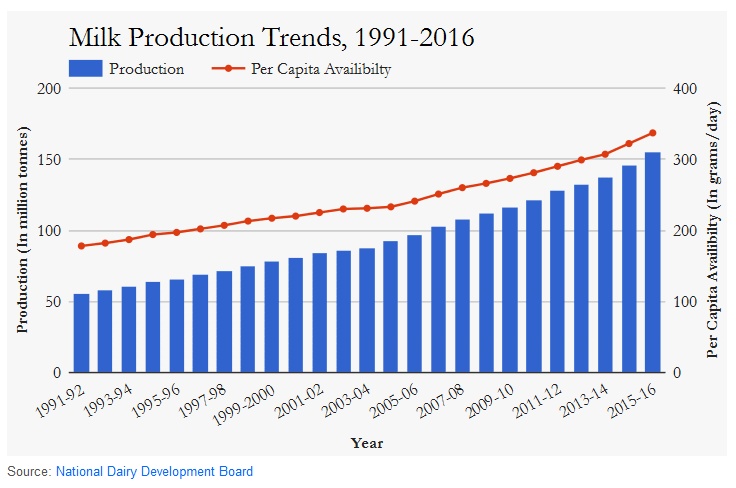How the White Revolution bought a change in India?
India attained freedom on 15th august 1947. The first-ever freedom movement emerged from Bengal and the struggle lasted for 90 long years which led us to freedom. No doubt movements and revolutions play an important role in society. One such movement was the White Revolution which shaped the nation beyond our imagination.
What is the White Revolution?
The White Revolution was one of the major dairy movements organized by the government of India, back in 1970. During this movement, the production of milk was regulated all over the nation and it is also ensured that the price of milk was not varied across regions.
The main aim of the movement was to establish a nationwide milk grid that would result in a link from all the large scale producers, industrialists of India with the small farmers reducing the scope of any middle man. The result of movement was such that, India transformed from a diary deficient nation to the largest producer of Milk in the world, and production of dairy was so enormous that it led to the export of products all over the world.
It helped India become a self-sufficient nation. But this is not how it all started!
What led to the White Revolution?
Operation flood was the program that led to the White Revolution movement. Launched on the 13th of January,1970, Operation Flood was the largest dairy development program and one of its kind. Launched by India’s National Dairy Development Board(NDDB) under the supervision of Verghese Kurien, the father of the White Revolution who was also the founder of AMUL.

It was actually launched to give farmers the benefit of the resources they create. As an employment generation program, it led to the mass production of dairy supplies. At the base of the white revolution were the farmers who by producing milk in large countries formed the foundation of the revolution.
Had it not been farmers of India, the government would not be able to do so. The successful implementation of the movement was because of the production by the masses and not just mass production.
Growth of the movement.
The movement was implemented in three phases :
Phase 1:
Phase 1 was financed by the profit made by the sale of skimmed milk powder and butter oil through the World Food Program. During this phase, 18 major milk sheds were linked with the consumers in India’s major metropolitan cities. And this led to the establishment of mother diaries in Mumbai, Delhi, Kolkata, Chennai. This phase was started in 1970 and lasted till 1979.
Some of the aims kept in mind during this phase:
- Improvement in the dairy sector in metropolitan cities.
- Increase of producer’s share in the milk market.
- The speedy development of diary animals to increase production.
Phase 2:
Activities during phase two:
- During this phase(1981-1985), the milk sheds which were initially 18 were increased to 36.
- Milk outlets were expanded to 290.
- Domestic milk production was quadrupled.
- a self-sustaining system of co-operatives and producers was established.
All these activities resulted in making India self-reliant and marketing of milk was increased by several million liters. To conclude India was moving forward!
Phase 3:
During this phase (1985-1996) the number of milk sheds peaked at 173.
Aims of phase 3:
- It emphasized on research and development in animal health and nutrition.
- It aimed at expanding the infrastructure required to procure the market.
- increased services for artificial insemination.
All these contributed to the enhanced productivity of milk-producing animals.
Objectives of the movement
Objectives of the white revolution include:
- Increased milk production
With this aim, the government wanted to enhance the economy of the nation. Increased milk production would not only make India self-sufficient but also expand its business overseas. And this is what happened. With large scale production, India became an exporter of dairy products.
- Augmented incomes of people in rural areas
We know that farmers support a major part of India’s economy and to be economically stable, the government is required to make reforms that are beneficial for the farmers. So efforts were made to increase rural income.
- Fair prices to consumers:
The government aimed at regulating the prices of milk and its products all over the country. This was to ensure that consumers across the nation can buy dairy at fair prices without variations.
- Increased income of, and reduced poverty in participating farmers
The white revolution was aimed at maximum participation from farmers. This would increase their income and help them eradicate poverty. What a good way to give back to the people from whom we receive the most!
How White Revolution impacted?
White Revolution was successful in transforming India from a milk deficient nation to the world’s largest milk producer. It doubled the milk available per person which was the need at that time, moreover, India became self-reliant and was at the peak of its economy.
Some of the major changes of whites revolution:
- It made dairy farming India’s largest self-sustaining industry
- It became the largest rural employment provider.
- It hugely impacted the social as well as economic growth of the nation.
- All the small scale farmers and landless laborers were benefitted as they got employment under the revolution.
- The quality of the livestock improved
- Research centers were set up at Anand, Mehsana, and Palampur.
- metro dairies were set up in 10 metropolitan cities of the nation which increase the productivity and quality of milk and milk products.
- The father of the white revolution made it possible for the creation and success of AMUL in India which made India the biggest producer of milk as on date.
- India became the largest exporter of dairy and its products.

White Revolution was overall an amazing idea, which was driven by the motive to make India self-sufficient. And it did too. People were getting employment, poverty reduced and the economy was getting stable. And to achieve all these things from the only program is a tough task to do.
There were also criticisms regarding the increase in the breed of foreign cattle which resulted in the decimation of Indian breed. But as they say, there is no such thing called perfect!
Also read – How to make a website using WordPress.


